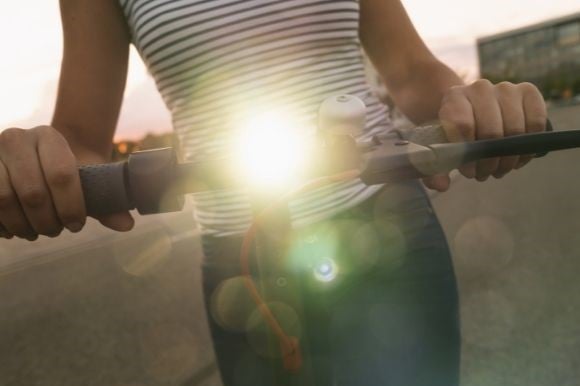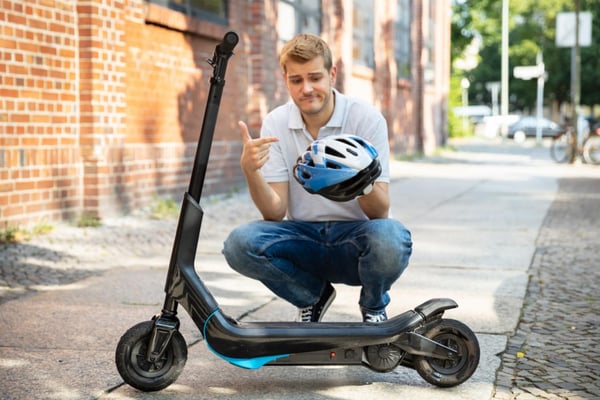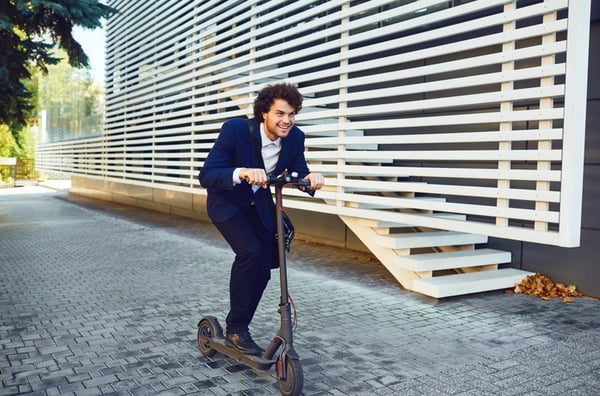Safety on your e-scooter is important so we've prepared some actionable tips for you to ride safer.
E-scooters are a fun, environmentally and budget-friendly, fast way to get around the city and to your desired destination. The rising number of e-scooter users proves in part that many people benefit from them, and that e-scooters will become a bigger part of our lives in the near future.
However, many people still fear them and are reluctant to use them as the media puts extra emphasis on recent accident figures. An e-scooter can sometimes be a dangerous device, yet with the right precautions and sufficient practice, the danger can be reduced to the same level as any other way of transport.
We will be listing some important precautions to take before riding an e-scooter so that everyone can benefit from the advantages while still ensuring safety!
Buy a safe scooter
Just like for any sort of transportation, the quality of the vehicle is crucial. It all starts with buying a safe e-scooter. The difference between a good and a bad scooter can change the whole experience. When riding an e-scooter, there are going to be many outside obstacles. Careless pedestrians, cars, bumps on the road, packed shopping streets - you name it.
This is why good brakes are key. They have to be effective, reliable and easy to use. What also matters is the quality of your tires. Qualitative tires will smoothen your ride by absorbing the shocks of obstacles on the road better and by increasing the grip/traction. Take a look at our purchasing guide for more information on brake systems and the ideal width of tires.
Knowing the specifications, features and capabilities of the e-scooter you purchased is really important. It will strengthen your understanding of how to properly use your device.
Note also that the maintenance of your e-scooter is just as important as buying a high-quality scooter. Companies like Cyclecure can help you with this.
Lights

Taking data from the NHTSA, most bike deaths happen between 6 pm-9 pm. That is why increasing the visibility of your e-scooter to other traffic participants should be on your list of precautions to take. Make sure you turn both your front and rear lights when you ride. As explained in our blog article about the winter preparation of your e-scooter, on the app for your device, you are most likely to have the option for your rear light named “always-on”.
Some other items to consider are luminous vests, helmets with LED lights, or simply reflective stripes on your e-scooter. The latter are usually positioned at the sides of the deck, the fenders, or the rims of the wheels. LED stripes on the other hand are often put at the bottom or sides of the deck or alongside the stem.
Wear a helmet

The next precaution is probably what you expected - Yes, wear a helmet! You may not like it, but wearing a helmet while riding an e-scooter will drastically reduce the number of possible critical injuries. According to the World Health Organization (WHO), “wearing a helmet is the single most effective way of reducing head injuries and fatalities resulting from motorcycle and bicycle crashes”. The same applies to e-scooters. Head injuries are among the most common injuries in scooter accidents!
In 2019, two studies conducted by the University of California Los Angeles and the Center for Disease Control and Prevention found that head injuries, including concussions and brain bleedings, represent almost half of all reported scooter injuries.
Many people do not wear them, whilst they really should.
Similarly, wearing knee and elbow pads would also add to the safety of your ride as they will prevent abrasion of these parts.
In case you do find yourself in the situation that you are about to fall, try to let go of the handlebar and keep your balance as much as you can. You have to use your hands to protect your head under any circumstances.
Experience
Practice makes perfect. With experience on your side, you can significantly reduce the risk of a fall in the first place. The majority of incidents relating to e-scooters is caused by the lack of experience & competence of the driver. Nevertheless, this can easily be changed. Practicing and improving your riding skills will definitely help reduce the number of accidents.
After purchasing an e-scooter, practice in an empty space, before jumping into the busy streets of the city, if it’s your first time riding one or if you feel a bit insecure. We recommend going to an empty parking lot and getting a feeling for how the brakes work and the throttle feels.
You should also check the following things before your first - and in fact, every other ride:
- Are the tires in good condition? Are they inflated enough? 🔘
- Is the folding mechanism locked into place? 🛴
- Do my brakes work properly?
- Is my battery charged enough?🔌
- Does the scooter make any abnormal noise or is there anything unusual? 👂🏻
- Do I have a gear bag for longer rides? (pump, multi-tool) 🧰
- Do I have my mobile phone (for emergencies)? 📱
Here’s also a tip to improve your riding skills: Don't lock your knees! You should be able to react to the condition of the street as you ride. Slightly bending your knees will assist with reducing the shocks as you move over rough surfaces, as will slightly raising your heels. Locking your knees, i.e. fully extending and tensing up your knees, is an unhealthy body posture that slows down your reaction to obstacles on the road.
Always look forward and plan the most secure line to follow. It may be an obvious tip, but it is also suggested to ride without headphones or anything that will distract you otherwise you are more likely to overlook important traffic signs or for example, a pedestrian taking a sharp turn in front of you.
That also includes not looking at your phone whilst riding - keep both hands on the throttles for stability. If you need to check your messages, pull to the side and come to a halt.

More advanced tips
Turning
When you turn at a low speed (<8 km/h), use your handlebars to steer. At high speeds, leaning in to turn usually helps. Remember that your handlebars are there to keep you balanced, but your feet and legs should be doing most of the work.
What also happens sometimes is that e-scooter riders collide because they look back over their shoulder, e.g. to see the cars behind them before a turn. This can bring you out of balance more quickly than you may think. To reduce the risk of losing balance, slow down before looking back! In this way, even if you fall, your injuries won’t be as serious as at a higher speed. Alternatively, there are also accessories you can buy with which mirrors can be attached to your e-scooter. Sometimes scooters also have indicators for turning on the handlebar - make sure to use those indicators if your device is equipped with them!
Obstacles on the road
There is an object ahead of you that you cannot avoid? Roll over it straight, i.e. perpendicular to the object. Try shifting your weight over the rear wheel and hopping the front wheel over the obstacle a little by slightly tugging on the handlebars. The front should not leave the ground though. What you want to do is decrease the weight of the front wheel to trespass the obstacle more safely.
Another tip is if there is a bump on the ground, keep your speed between 5-10 km/h when you ride over it.
Most accidents occur with pedestrians and other e-scooters however. They are often not serious but avoid pedestrian areas as much as possible and respect speed regulations (usually around 6-8 km/h) on busy streets.
Especially in Belgium, also pay attention to weather conditions, such as rain, snow, and fog as slippery roads and limited visibility will demand more focus and caution from you. You can also prepare your e-scooter for the winter and rain to reduce slippage risks and malfunction.
Clothing
This one is more of an extra tip, but try to avoid wearing too many accessories, like earrings or long bracelets. If you do have an accident, such items might worsen your injuries. What could also happen is that your bracelet may suddenly get stuck somewhere in the scooter - so could a long floating dress. Wear clothing that is warm enough and if possible, clothing that covers most of your skin. Clothes can act as a protective layer if you fall off.

Know the rules of the game
Last but not least, knowing the traffic rules and regulations for riding an e-scooter in your city is essential. It’s your responsibility to be informed. Learning and understanding the priority rules will help you know when to stop, give priority and avoid accidents.
To quote Ms. Kosecki (2019): “If you're not allowed on the sidewalk, stay in the road. If you're riding alongside traffic, use hand signals. Wear reflective clothing and if you need to carry something, bring a backpack. Hanging a bag off the handlebars or on one shoulder can throw you off balance.”
Note that these regulations change from country to country, sometimes even from city to city - it’s up to you to research these rules before going on a ride in a foreign city.
Following these safety precautions will help you benefit from the many advantages of e-scooters in a safer and more responsible way, and will protect you and other people. We hope you take your and others’ safety to heart with these quick tips.
When was the last time you did a full check-up of your e-scooter?
Schedule a safety check-up at Cyclecure
Tags:
safety of your e-scooter
February 24, 2022
